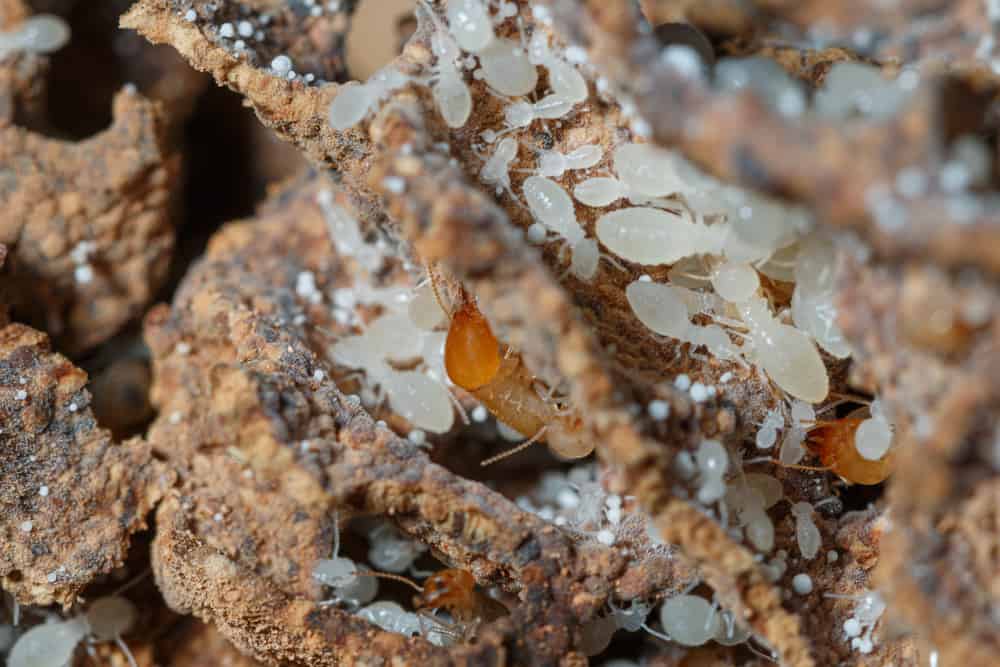While there’s plenty of division in the world, it seems like all of humanity is united in their attitude toward dealing with termites. The idea is so terrifying that even the slightest hint of termite larvae around your home may have you looking up what they look like.
In short, termites look the same for most of their life cycle, and termite larvae are simply smaller, paler versions of the adults. They have a thick waist, straight antennae, six short legs, and possibly a set of 4 wings (2 on each side).
As they get older, termites mature into specific castes in the colony structure, and they take on the physiology needed by that caste. We dive deeper into this, as well as how to respond to the appearance of termites in your home, in the article below.
What Do Termite Larvae Look Like?
The Termite Life Cycle
Termites have a simple life cycle. The queen lays eggs that hatch into larva, and they remain this way until they mature into adults and develop into a particular caste member.
Termites are hemimetabolous insects, meaning they do not have a cocoon stage like maggots or other bugs they’re confused for. Instead, they go through several molts and discard the outer shells until they reach maturity.
Eggs
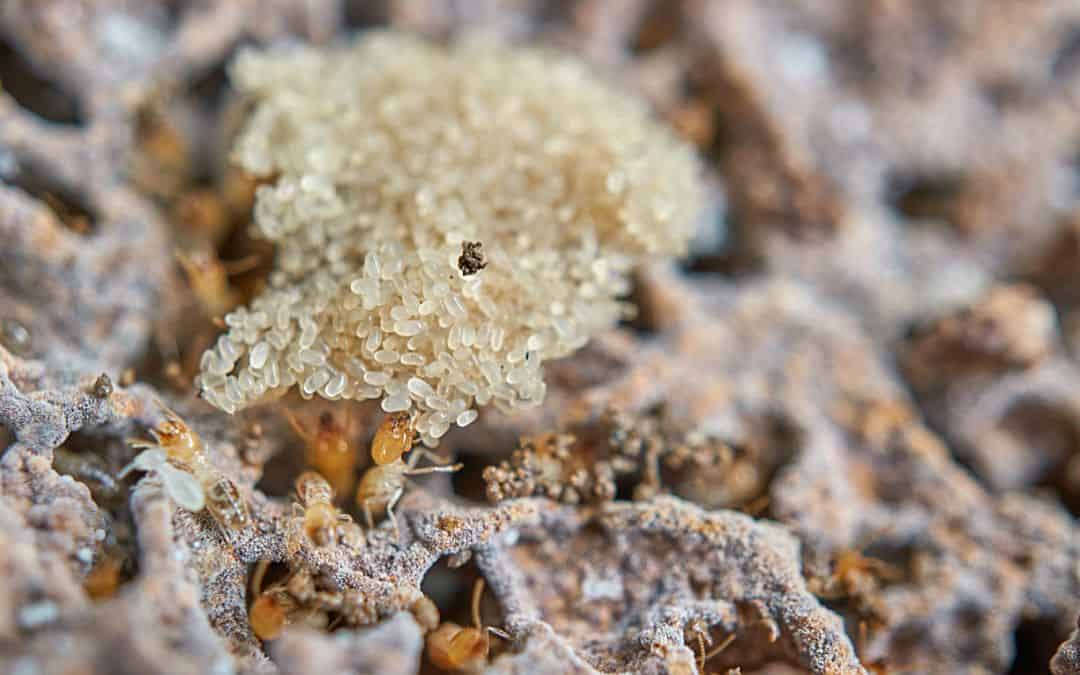
Credit: stampedepestcontrol
Queens lay thousands of eggs over their lifetime, starting out with small quantities and laying more and more eggs with each batch.
These eggs are incredibly tiny, only about 0.25 mm when first laid and up to 1.0 mm as they develop. They get smaller the older the queen gets to make room for the increased number of clutch mates she lays.
In young colonies termite eggs are laid and hatch in the royal chamber. The queen will never leave this area after she lays her first batch, and as it becomes overcrowded the worker termites will build nursery cells, collect the eggs, and relocate them.
Larvae
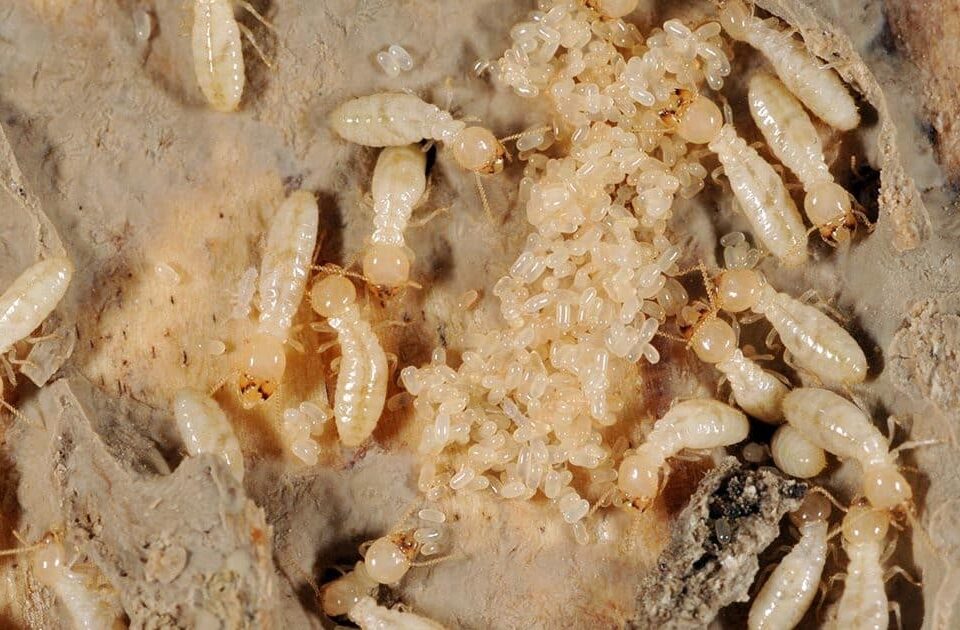
Credit: pestsguide
A termite larva (singular; larvae plural) emerges as a miniscule version of the adult it turns into. Larvae are only a bit longer than the egg that they hatched from, and they have near-translucent soft white bodies.
While they’re considered nymphs after their first molt, the termite larvae never really enter a traditional mint stage. Instead, they come out fully formed, with six legs and two antennas, ready to grow and eventually take over the mound.
Termite Larvae Compared to Other Insect Larvae
Termite larvae are regularly compared to maggots and juvenile ants.
While they’re white and soft-bodied like maggots, the maggots are larger and do not have wings, legs, or eyes. Maggots will eventually enter a pupatic state and then emerge as flies, while termite larvae simply grow into larger termites as they mature.
Termite larvae appear most similarly to carpenter ant larvae. While regular ants look like a tiny tube of rice when they’re born, carpenter ant larvae have an abdomen. Like termite larvae, you can see the heads and the thorax.
It’s easier to distinguish the difference between the two as they age and you inspect the damage done to structures. Carpenter ants retain the wings that would normally break off a mature termite, and their tunnels are much smoother than the paths termites carve.
Adults
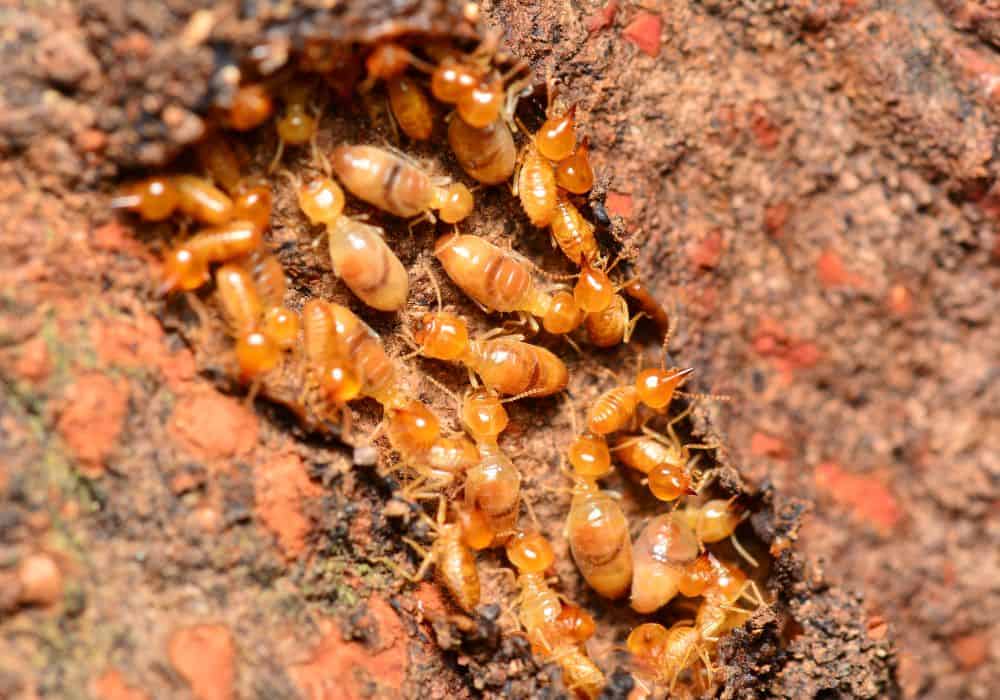
While termite larvae look like adult termites, they will lack the defining characteristics of the caste members they grow into. This occurs after their final molt, and they will retain this appearance for the rest of their lives.
The caste a termite goes into depends on what the colony needs the most. Any thin areas are filled in as new termites hatch, and the colony is kept in near-perfect balance.
These castes include:
- Worker Termites: most populated caste; soft bodies with no eyes (appear as closely to larvae state) perform all the tasks needed to maintain colony; can develop into soldier or reproductive termites if needed; short lives
- Soldier Termites: built to guard the nest and stand position at entries and exits; feature overdeveloped mandibles useful for tearing enemies apart; secrete toxic chemical from fontanelle to deter intruders and prevent entry; must be fed by worker termites
- Secondary Reproductive Termites: backup breeders who can take over if something happens to the royalty; do not have wings or eyes; do not leave the nest; cannot lay as many eggs as a queen termite
- Alates: reproductive termites with the ability to go on mating flights and reproduce with other colonies; have tougher skin and eyes; queen termites have a hugely distended abdomen to produce thousands of eggs per day
Apart from the royalty, most termites live a maximum of 2 years.
Where do You Find Termites?
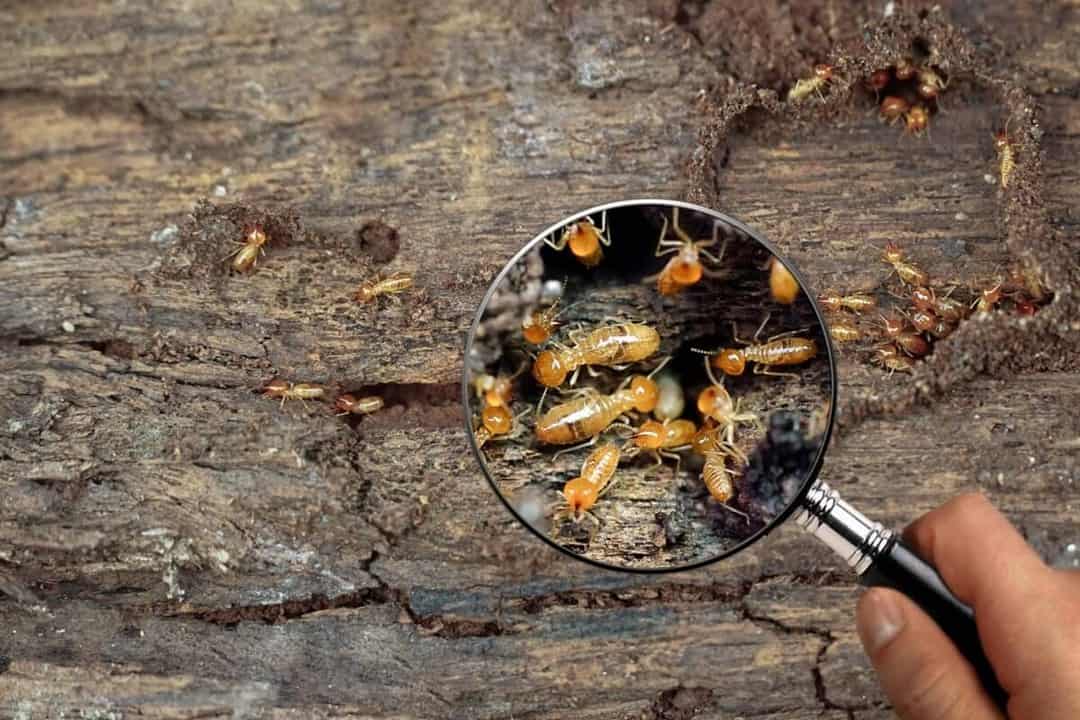
Credit: aatm2008
Where you find termites depends mostly on what type of termites you’re dealing with.
Drywood termites prefer to nest directly in dry wooden structures, while dampwood termites prefer any decaying or damp wood around your home. This can be a rotting tree or water-damaged part of your house.
Subterranean termites differ from the wood-preferring termite colonies by needing direct contact with the soil. They need the moisture from the ground to survive, and they will set up tunnels from the ground to whatever structure they’re commandeering.
Where You Find Termite Larvae
You shouldn’t see termite larvae outside of the nest, so it’s more likely you’ve come across baby ants than young termites. However, seeing them outside the nest is a sure sign of a termite infestation.
Think back to what baby termites look like. They’re ill-suited for combatting predators, let alone staying hydrated if exposed to the elements. Workers focus on building nursery tunnels around the very center of the nest, keeping the nymph termites as safe as possible until they enter the workforce.
Getting Rid of Termites
If you discover termites in your home, we strongly recommend reaching out to a professional to get rid of them. Termites can do a lot of damage by the time they’re detected, and those trained in termite control will know how best to respond to every situation.
They can work with you to use a method that’s safe for you and your family while being effective in removing the termite colony from your home. They will also set you up with a way to prevent termites from moving back in.
Getting rid of termites usually involves one or more of these methods:
- DIY pest control solutions
- Physical destruction of the nest
- Termiticidal dust, spray, or bait
- High heat or fumigation
You may need to repeat treatment until all traces of the colony are gone.
DIY Methods
DIY methods may be the most comfortable and accessible for you, but they lack the power needed to take out a full termite colony. They usually work by deterring termites, although they have a slight chance to kill on contact.
These include:
- 1:1 vinegar with water sprayed on suspected areas
- Water (or the vinegar mix) with lemon and/or orange oil sprayed on suspected areas
- Washing powder dissolved in water sprayed on affected areas
You can also try moving any affected wooden furniture in direct sunlight to see if that deters the termites from living in it. They should move out in favor of more shaded wood.
Physically Destroying the Nest
Destruction of the nest is essential to throw the colony in disarray. It will house the workers and the nymphs, and you can take out a substantial amount of the population if you handle them here.
We recommend destroying the nest only after you deploy a bait pesticide and have a contact killer to eliminate as much of the population as possible. Only destroy the nest in a way that will not further compromise your home or the structure they’ve taken up in.
You can dig into subterranean nests using a shovel, uncovering the tunnels and chambers underneath. Regardless of where the nest is, the soldiers will come out ready to fight. You may even dig deep enough to see the larvae and royal termites.
Dust, Spray, and Bait Pesticides
Dust is the least invasive chemical option, and it’s effective in moving through the colony. While sprays make great contact killers, dust will allow you to infiltrate the colony and effectively take them out at the root.
You usually spread the dust in areas that the termites travel through, usually any entrances you can find. The workers pick it up as they leave and return from foraging, taking it deep into the nest as they distribute the food and groom the other castes.
You can also set out bait traps that they harvest from and take back to the nest. Follow up with a spray when you eventually deploy your all-out attack on the nest.
Heat and Fumigation
High heat is arguably the quickest and most effective method of handling termites, but it can be costly, further damage your home, and must be handled by a professional. Structures must reach temperatures exceeding 120°F to effectively kill the termite population.
Likewise, fumigation deploys an insecticidal gas to every last nook and cranny in your home. While effective, you will need to leave the house for several days to allow plenty of time for the gas to kill the colony. It’s inconvenient but a great way to deal with a major infestation.
Conclusion
Hopefully, learning what termite larvae look like confirms that the bugs in your home are not termites. If not, you should respond as quickly as possible to prevent the infestation from worsening.
Remember to:
- Identify the nest location for quickest and most efficient removal
- Contact a professional to make sure the method you choose is best suited to your situation
- Follow up by setting a barrier to discourage new colonies from moving in
If we’ve missed anything, please comment your questions or remarks below!
